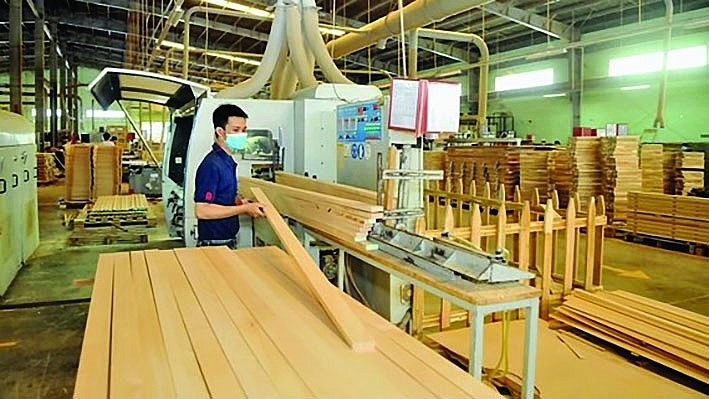
During the first half of 2023, wood furniture exports experienced a significant decline of 33.1%. In particular, the major market for Vietnam's wood industry, the United States, saw a sharp reduction of 32.8%.
Sharp decline after years of double-digit growth
Discussing the wood export situation, Mr. Ngo Sy Hoai, Deputy Chairman and General Secretary of the Vietnam Timber and Forest Product Association (VIFOREST), stated that the export value of the wood industry has experienced a significant decline after years of double-digit growth. The reasons for this decline, in addition to general factors such as geopolitical conflicts, inflation, and reduced consumer demand, include the initiation of investigations by the United States market into certain wood and wood products from Vietnam, regulations related to the environment and forests by the EU...
Analyzing the significant market of the wood industry, Mr. Ngo Sy Hoai noted that the United States is a major market for Vietnam's wood industry, accounting for 50-55% of the total export value. In 2022, despite the ongoing Covid-19 pandemic, Vietnam managed to export 8.3 billion USD worth of wood and wood products to the United States. Particularly, even during the previous year of the pandemic, the export value was nearly 9 billion USD.
"Vietnam's wood products typically account for 35-40% of the total wood product imports in the United States. However, this year, the export of wood and wood products to the United States has decreased significantly, even more than the average decrease. Specifically, wood and wood product exports to the United States in the first 6 months decreased by 32.8%. Compared to the overall Vietnam-US export value decrease of over 21%, the wood industry has experienced a more severe decline," noted the VIFOREST representative.
According to Mr. Ngo Sy Hoai, aside from the general economic situation with tightened consumer spending, the wood industry is affected by the real estate sector's downturn. "Wood products are often linked to the real estate industry. In the United States, the real estate market was slow during the early months of the year. As a result, the total import value of wood products from all sources to the United States has decreased, not just from Vietnam," explained Mr. Ngo Sy Hoai.
Although the results for the initial months of the year are not promising, Mr. Ngo Sy Hoai still sees optimistic signals. For instance, concerning the US market, exports in June to this market amounted to 638 million USD, only down by 18.4% compared to the same period. Therefore, the VIFOREST representative believes that in the upcoming months, as the market situation gradually improves, the decline might be less severe than now. Vietnamese enterprises have established their position in the market, showcasing true competitive strength.
Regarding wood industry businesses, Ms. Le Hai Lieu, representative of Duc Thanh Wood Company, also expressed some signs of optimism. Some units have continued to place orders, inquire about products, and even announced the quantities they plan to order in the future. However, the overall situation has not fully returned to normal. The representative from Duc Thanh Wood Company believes that the decline in sales is due to the general economic downturn and consumer tightening of expenditures due to difficult living conditions. If the economic situation stabilizes, the demand will be substantial once again.
Capturing Optimistic Signals
Mr. Ngo Sy Hoai believes that despite facing significant challenges, there's no need to be overly pessimistic, as this is only a temporary situation. To regain export growth for the industry, including wood products, he emphasized the need for support from the Ministry of Industry and Trade, marketing efforts to seek markets for Vietnam's wood products, conveying the message of strong commitment to providing legal wood products, and preparing to strictly implement EU regulations.
According to the representative of the Vietnam Trade Office in Canada, there is still great potential for exporting wood products to the Canadian market. For example, wood products and wood charcoal are items with promising potential for rapid growth in the territory. Each year, Canada imports about 4 billion USD worth of these products. Although there was a significant decrease in demand from Canada for these products in the first months of 2023 compared to the same period in 2022 (down by 17.2%), along with Germany, Mexico, Vietnam is a market with high export growth to Canada.
Currently, Canada is reducing imports from China, which presents Vietnam with many opportunities to increase export volume for this product group. If the growth rate remains as in the initial months of the year, it is projected that in 2023, Vietnam could export about 45 million USD worth of wood products to Canada. This is a high-growth item for Vietnam after the CPTPP, increasing from 11 million USD to 32 million USD, a 233% increase.
Mr. Tran Ngoc Quan, Commercial Counselor at the Vietnam Trade Office in Belgium and the EU, stated that the EVFTA agreement has helped Vietnam's textile, footwear, and wood industries increase exports to the EU. To fully benefit from these advantages, adhering to rules of origin is crucial. Furthermore, as the EU transitions to a circular economy, domestic businesses need to adapt, as the implementation of regulations will strongly impact on their exports. The Vietnam Trade Office is ready to support domestic enterprises in participating in trade fairs, seeking business connection opportunities, and expanding export possibilities in the EU.
In the United States, a potential export market for many industries, including wood products, Mr. Do Manh Quyen, Head of the Trade Office Branch at the Vietnam Trade Office in Houston, believes it's important to identify reasons and solutions to overcome the growth slowdown. Businesses need to redefine their domestic production and business strategies, clearly define markets and products, understand regulations and barriers to export to major markets like the United States, and improve product quality and production technology.
To develop the market, businesses should look beyond major distribution channels and explore niche markets. Large distributors can pose a challenge because they may cut ties when demand decreases, disrupting the export activities of businesses. Especially when promoting trade, it's important to engage with local businesses and individuals, sign advisory contracts to identify niche markets, and address inventory and miscellaneous issues.
Source: VCN
Keywords: import, export, wood, wood exports



















